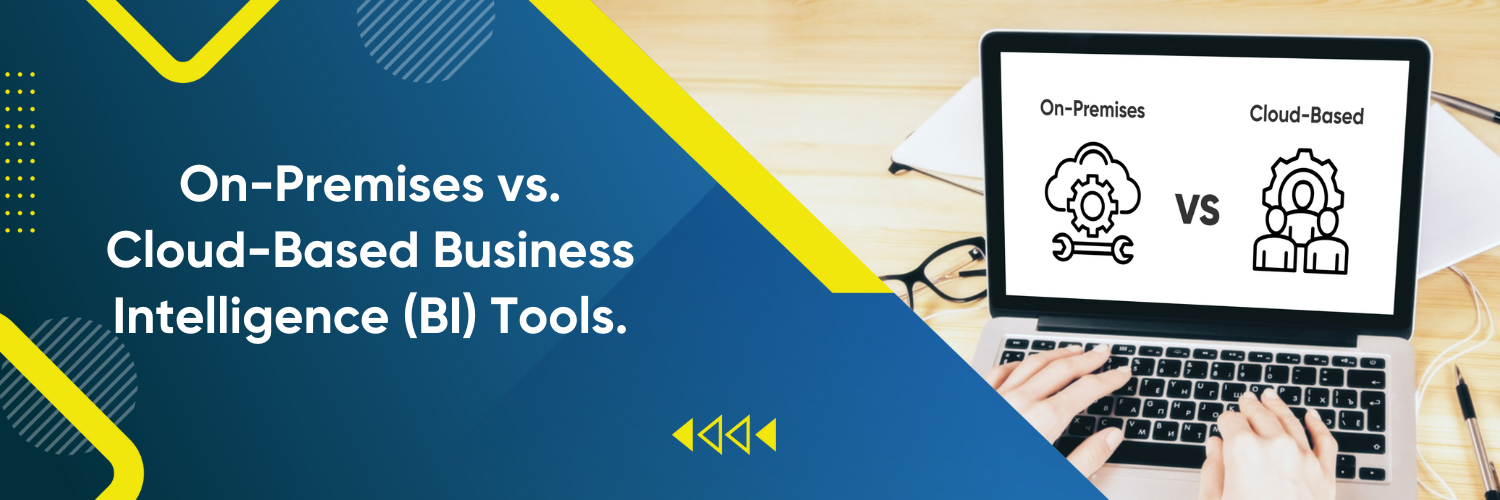On-Premises vs Cloud-Based

Business Intelligence (BI) tools are crucial in modern business decision-making. These tools enable organisations to gather, analyse, and visualise data, providing valuable insights that drive informed choices. Regarding BI tools, there are two primary options: on-premises and cloud-based solutions.
On-Premises Business Intelligence Tools

On-premises BI tools are installed and hosted on the organisation’s servers and infrastructure. This approach provides businesses with greater control over their data and infrastructure. With on-premises BI tools, organisations can tailor the solution to meet their needs and integrate it seamlessly with existing systems.
One of the critical advantages of on-premises BI tools is data control and security. Since the data is stored internally, organisations have direct control over access, privacy, and compliance. This level of control is particularly critical for businesses operating in regulated industries or those handling sensitive customer information.
Additionally, on-premises BI tools offer customisation and flexibility. Organisations can customise the tool to align with their unique requirements, such as specific data sources or business workflows. This flexibility allows for a more tailored and optimised BI solution that caters to the organisation’s particular needs.
However, on-premises BI tools also come with some disadvantages. One major drawback is the high upfront costs associated with infrastructure setup, software licenses, and hardware requirements. Moreover, organisations are responsible for ongoing maintenance, updates, and infrastructure management, which can be resource-intensive and require dedicated IT personnel.
Cloud-Based Business Intelligence Tools
Cloud-based business intelligence (BI) refers to the use of cloud computing technologies to provide businesses with analytical and data management tools. This approach leverages the scalability, flexibility, and cost-effectiveness of the cloud to make BI tools more accessible and efficient. With cloud-based BI, businesses can store vast amounts of data on remote servers, which can be accessed and analyzed in real-time from anywhere using web-based interfaces. This enables faster, data-driven decision-making and reduces the need for large IT infrastructures and upfront investments.
Moreover, cloud BI tools often have advanced features like artificial intelligence, machine learning, and predictive analytics, which help extract meaningful insights from complex datasets. This democratizes access to powerful analytical tools, allowing even small businesses to compete with larger organizations by harnessing the power of data. The pay-as-you-go cloud services model also makes it easier for businesses to scale their BI capabilities in line with their growth. Cloud-based business intelligence represents a significant step towards more agile, responsive, and data-driven business strategies.
Cloud-based BI tools, on the other hand, are hosted and operated by third-party service providers. These tools leverage cloud infrastructure to offer businesses a scalable and accessible solution. Cloud-based BI tools allow organisations to access their data and insights from anywhere, as long as they have an internet connection.
Scalability and flexibility are significant advantages of cloud-based BI tools. With cloud infrastructure, businesses can quickly scale up or down based on their needs. This elasticity allows organisations to handle varying data volumes and user demands without significant upfront investments in hardware or infrastructure.
However, data security concerns are often raised when considering cloud-based BI tools. Organisations must carefully evaluate the service provider’s security measures, which enforce data privacy, compliance, and protection against potential breaches. Dependency on internet connectivity is another potential drawback, as any disruption in internet access could hinder real-time access to data and analytics.
Considerations for Choosing the Right BI Solution
When deciding between on-premises and cloud-based BI tools, several key factors should be considered:
- Business needs and requirements: Evaluate your organisation’s specific needs, such as data sources, scalability requirements, and integration capabilities with existing systems.
- Data security and compliance: Assess the level of data security and compliance measures provided by both options, considering factors such as data encryption, access controls, and regulatory requirements.
- Scalability and growth potential: Consider the anticipated growth of your business and whether the BI solution can accommodate expanding data volumes and user demands.
- IT infrastructure and resources: Evaluate your organisation’s existing IT infrastructure and resources, including hardware, technical expertise, and maintenance capabilities, to determine the feasibility of an on-premises solution.
- Total cost of ownership (TCO) analysis: Conduct a comprehensive cost analysis, comparing upfront costs, ongoing maintenance expenses, and subscription fees to determine the most cost-effective option in the long run.
Best Practices for Implementing BI Tools

- Defining Clear Objectives and Goals: Clearly outline the objectives and goals you want to achieve with implementing the BI tool. Identify the key metrics and insights that will drive your business decision-making.
- Conducting a Thorough Needs Assessment: Assess your organisation’s data sources, data quality, and data integration requirements to determine the necessary functionalities and capabilities of the BI tool.
- Engaging Stakeholders and End-Users: Involve key and end-users throughout the implementation process. Seek their input and feedback to ensure the BI tool meets these needs and requirements.
- Training and Support for Users: Provide comprehensive training and ongoing support to users to ensure they can effectively utilise the BI tool and maximise its potential for informed decision-making.
- Ongoing Monitoring and Optimisation: Continuously monitor the performance of the BI tool, assess user feedback, and identify areas for improvement. Regularly optimise the tool’s configurations and workflows to enhance its effectiveness and user experience.
Benefits of Using On-premises BI Tools
Data Control and Security
On-premises Business Intelligence (BI) tools offer a level of data control and security that is particularly beneficial for certain industries with stringent data security and compliance requirements. When you manage your BI tools on-premises, you have complete authority and oversight over your data. This control is crucial in sectors like finance, healthcare, and government, where data sensitivity is paramount. With on-premises solutions, data is stored and processed within the physical confines of your organization, providing a higher degree of security against external threats. Additionally, you can implement custom security protocols and measures that align precisely with your organization’s standards and compliance requirements.
Performance
When it comes to performance, on-premises BI solutions often have a distinct advantage. Operating within a local network, these systems can offer faster query responses and reporting performance compared to cloud-based solutions. This is primarily because on-premises systems reduce latency and data transfer times that can occur when data needs to be sent over the internet to a cloud-based service. For businesses that handle large volumes of data or require near-instantaneous data processing and analysis, this speed can be a critical factor.
Customisation
On-premises BI tools offer an unmatched level of customization and flexibility, which is a significant advantage for businesses with unique needs. This level of customization allows companies to tailor the BI tools to fit their specific requirements precisely. You can modify the software to better align with your business processes, integrate seamlessly with other on-premises systems, and even develop custom modules or functionalities that are unique to your organization. This can be particularly beneficial for businesses with legacy systems or requiring integration with specialized hardware or software.
Data Privacy
For organizations handling sensitive data, on-premises BI tools offer a significant advantage in terms of data privacy. With these tools, data remains within the organization’s physical infrastructure, thus reducing the risk of external breaches and unauthorized access. This is a critical consideration for sectors where data privacy is not just a preference but a legal requirement.
Cost Predictability
On-premises BI solutions offer a clear advantage in terms of cost predictability. While these solutions typically require a higher upfront investment for hardware, software licenses, and infrastructure setup, the ongoing costs tend to be more predictable. This predictability stems from the absence of recurring monthly or annual subscription fees associated with cloud services. Once the initial investment is made, the organization can plan for more stable, long-term operational costs.
Benefits of Cloud-Based BI Tools
Scalability
Cloud-based Business Intelligence (BI) tools offer unparalleled scalability, which is a crucial advantage for businesses in today’s rapidly evolving market. The beauty of cloud scalability lies in its flexibility; companies can effortlessly scale up or down their BI capabilities in line with their current needs and budgets. This adaptability is particularly beneficial for businesses experiencing fluctuating or seasonal demands. With cloud BI, there’s no need for substantial upfront investments in hardware or software. Organizations can opt for subscription-based models, paying only for the resources they use. This approach eliminates the risk of over-provisioning, ensuring that businesses are not stuck with excess capacity during quieter periods. Moreover, scaling up the BI infrastructure becomes a seamless process as the business grows, without the traditional challenges associated with physical hardware upgrades or additional software licensing. This kind of scalability fosters a more agile business environment, where companies can respond quickly to market changes and opportunities.
Accessibility
The accessibility of cloud-based BI tools is a game-changer for businesses. These tools are accessible anytime, anywhere, as long as there’s an internet connection. This global accessibility is crucial for modern businesses that operate in multiple locations or have remote employees. It ensures that all team members, regardless of their physical location, have real-time access to critical business data and analytics. This level of accessibility fosters improved collaboration among teams and departments, leading to more cohesive and informed decision-making processes.
Automatic Updates
One of the significant advantages of cloud-based BI tools is the provision of automatic updates and maintenance. This aspect of cloud computing takes a substantial load off the IT departments of businesses. In traditional setups, updating BI tools can be time-consuming and technically challenging, often requiring downtime or additional resources. However, in a cloud environment, updates, including new features, enhancements, and security patches, are rolled out automatically by the service provider. This ensures that businesses always have access to the latest technology without additional effort or cost. It also translates into enhanced security, as updates often include patches for vulnerabilities, keeping the company’s data and systems safe from emerging threats.
Cost Efficiency
Cloud-based BI tools are cost-effective, providing a significant financial advantage over traditional on-premises solutions. The primary cost benefit comes from the lower upfront investment required. Traditional BI solutions often necessitate substantial initial expenditures on hardware, software licenses, and infrastructure setup. In contrast, cloud-based BI services typically operate on a subscription model, which considerably reduces the initial capital required.
Data Integration
Cloud-based BI tools excel in data integration capabilities, a critical factor for businesses that accumulate data from diverse sources. These tools are designed to integrate seamlessly with various data sources, cloud services, and APIs. This integration allows businesses to consolidate and analyze data from different platforms, such as CRM systems, marketing tools, financial software, and more, all in one place. The ability to aggregate and harmonize data from these disparate sources is essential for gaining a comprehensive business view.
Disaster Recovery
Disaster recovery is another significant advantage of cloud-based BI tools. The cloud inherently provides robust backup and disaster recovery solutions, ensuring that critical business data is protected against natural disasters, cyber-attacks, or system failures. Cloud providers typically store data across multiple geographically dispersed data centres, providing redundancy and minimizing the risk of data loss.
In practice, some organisations opt for a hybrid approach, combining on-premises and cloud-based BI tools to leverage the advantages of both models. This allows them to keep sensitive data on-premises while using the cloud for scalability, collaboration, and accessibility. Choosing on-premises and cloud-based BI tools should align with your organisation’s goals, resources, and data security requirements.
Conclusion

In conclusion, choosing between on-premises and cloud-based BI tools requires careful consideration of data control, customisation, scalability, costs, and security. Assessing your business needs, evaluating the advantages and disadvantages of each option, and learning from real-world examples will help you make an informed decision. Ultimately, aligning your BI strategy with your business goals is essential for driving success and achieving data-driven insights.
As you navigate the decision-making process for implementing the right BI solution for your business, it’s important to remember that every organisation’s needs and priorities are unique. By weighing the pros and cons of on-premises and cloud-based BI tools, you can make an informed choice that aligns with your specific requirements and goals.
To further enhance your BI capabilities and propel your business to success, consider partnering with Ubique Digital Solutions. Our team of experts specialises in developing and implementing tailored BI solutions that optimise data analysis, visualisation, and decision-making processes. Contact us now!
FAQs
Q: What is the difference between On-Premises and Cloud-Based BI tools?
The organisation hosts On-premises BI tools internally, providing data control and customisation. Cloud-based BI tools, however, are hosted and operated by third-party service providers, offering scalability and accessibility from anywhere with an internet connection.
Q: How Do On-Premises BI tools Ensure Data Security?
On-premises BI tools provide data security through measures such as internal access controls, encryption, and compliance with industry standards. Organisations have direct control over data privacy and can implement security protocols specific to their needs.
Q: Can Cloud-Based BI Tools Handle Large Volumes of Data?
Yes, cloud-based BI tools are designed to handle large volumes of data. Cloud infrastructure offers scalability, allowing businesses to scale up or down based on data requirements and user demands.
Q: Are On-Premises Bi Tools More Expensive than Cloud-Based Ones?
Due to infrastructure setup and hardware requirements, on-premises BI tools often involve higher upfront costs. Cloud-based BI tools follow a pay-as-you-go model, making them more cost-effective for businesses that prefer operational expenses over significant upfront investments.
Q: What Are the Common Challenges in Implementing BI tools?
Common challenges in implementing BI tools include data quality issues, integration complexities with existing systems, user adoption, and ensuring the chosen tool aligns with business objectives and user needs.






